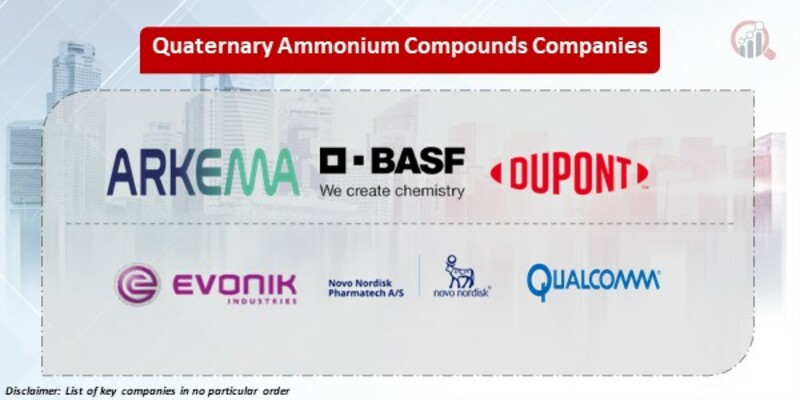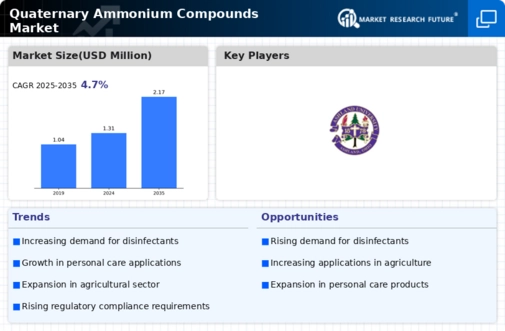Top Industry Leaders in the Quaternary Ammonium Compounds Market

The Quaternary Ammonium Compounds (QUATs) market boasts a steady growth trajectory, fueled by their diverse applications in disinfectants, personal care products, fabric softeners, and industrial lubricants. the competition within this space is heating up. Let's explore the key strategies adopted by players, factors influencing market share, and recent developments shaping the landscape.
Strategies for Success:
Innovation and Diversification: Players like Kao Chemicals and Solvay are focusing on developing novel QUAT derivatives with enhanced biodegradability, reduced toxicity, and broader antimicrobial spectrums. Diversification into niche applications like oilfield drilling fluids and textile finishing is also being observed.
Geographic Expansion: Emerging markets in Asia-Pacific and Latin America present lucrative growth opportunities. Companies like Lonza and Evonik are establishing production facilities and distribution networks in these regions to capitalize on the rising demand for hygiene and sanitation products.
Sustainability and Environmental Focus: The increasing emphasis on eco-friendly solutions is driving the development of green QUATs derived from renewable resources like plant oils. Companies like Stepan Company and AkzoNobel are offering readily biodegradable QUAT-based products to cater to environmentally conscious consumers.
Mergers and Acquisitions: Consolidation through M&A deals is another prominent strategy. The acquisition of Thor Chemie by Solvay in 2022 strengthened Solvay's position in the European QUAT market. Such moves allow companies to expand their product portfolios, acquire new technologies, and optimize production efficiencies.
Partnerships and Collaborations: Collaborations with research institutions and universities are fostering innovation in QUAT development. Additionally, partnerships with distributors and retailers are crucial for ensuring efficient market penetration and reaching a wider customer base.
Factors Influencing Market Share:
Regulatory Landscape: Stringent regulations governing the use of QUATs, particularly in personal care products and food contact materials, can impact market dynamics. Companies with strong compliance expertise and a portfolio of regulatory-approved products gain a competitive edge.
Raw Material Prices: Volatility in the prices of key raw materials like alkyl chlorides and amines can affect profit margins. Efficient sourcing strategies and long-term supply contracts become critical for cost optimization.
Technological Advancements: The development of new production technologies and efficient delivery systems can lead to cost reductions and improved product performance. Companies investing in R&D to stay ahead of the curve will stand out from the competition.
Brand Recognition and Marketing: Establishing a strong brand image and implementing effective marketing campaigns are crucial for driving consumer preference and increasing market share.
Key companies in the quaternary ammonium compounds market include
-
Arkema
-
BASF SE
-
DuPont
-
Evonik AG
-
Ashland
-
Novo Nordisk Pharmatech
-
Amines Company Pte. Ltd.
Recent Developments:
October 2023: Ecolab introduces a line of sustainable QUAT-based cleaning products made from plant-derived ingredients, catering to green-conscious consumers.
November 2023: BASF announces plans to expand its QUAT production capacity in China to meet the growing demand from the Asia-Pacific region.
December 2023: Lonza and Stepan Company form a strategic partnership to develop and commercialize a novel biodegradable QUAT for use in fabric softeners.

